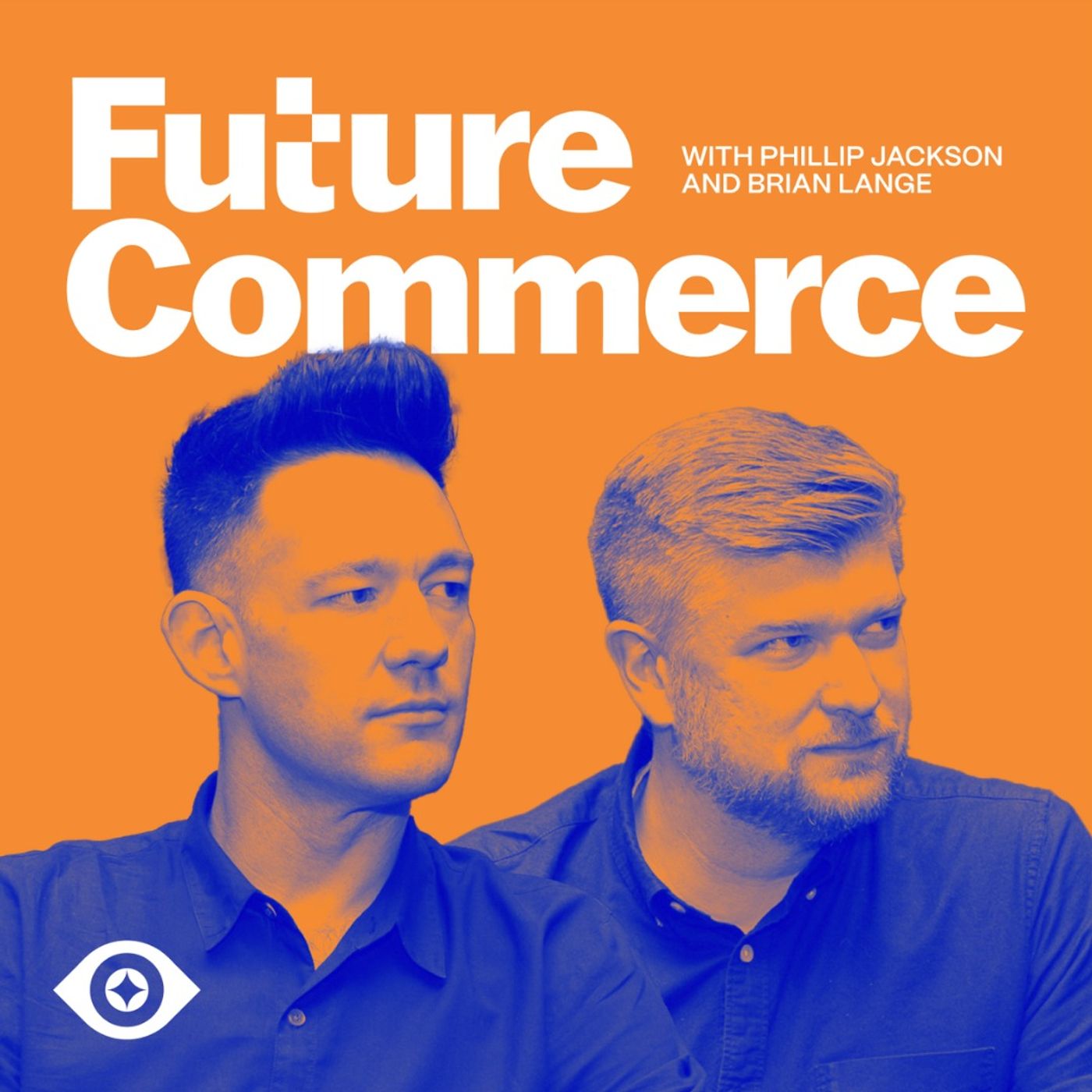Discover Future Commerce
Future Commerce

Future Commerce
Author: Phillip Jackson, Brian Lange
Subscribed: 291Played: 11,942Subscribe
Share
©2025 Future Commerce
Description
Future Commerce is the culture magazine for Commerce. Hosts Phillip Jackson and Brian Lange help brand and digital marketing leaders see around the next corner by exploring the intersection of Culture and Commerce.
Trusted by the world's most recognizable brands to deliver the most insightful, entertaining, and informative weekly podcasts, Future Commerce is the leading new media brand for eCommerce merchants and retail operators.
Each week, we explore the cultural implications of what it means to sell or buy products and how commerce and media impact the culture and the world around us, through unique insights and engaging interviews with a dash of futurism.
Weekly essays, full transcripts, and quarterly market research reports are available at https://www.futurecommerce.com/plus
Trusted by the world's most recognizable brands to deliver the most insightful, entertaining, and informative weekly podcasts, Future Commerce is the leading new media brand for eCommerce merchants and retail operators.
Each week, we explore the cultural implications of what it means to sell or buy products and how commerce and media impact the culture and the world around us, through unique insights and engaging interviews with a dash of futurism.
Weekly essays, full transcripts, and quarterly market research reports are available at https://www.futurecommerce.com/plus
624 Episodes
Reverse
Fresh from the Javits Center, Phillip, Brian, and Alicia unpack NRF 2026's dominant themes, from AI's omnipresence to its curiously low adoption among the very professionals championing it. The conversation moves beyond technology theater to explore what truly drives commerce: cultural connection, intentional brand heritage, and multiplayer engagement that treats customers as collaborators rather than data points.2026 Brought Us An AI Wake-Up CallKey Takeaways:AI saturation at NRF contrasts sharply with minimal executive adoptionSuccessful AI integration preserves brand heritage rather than replacing itMultiplayer brand engagement becomes reality through tools like Taco Bell's Fan StyleplatformAnalog intimacy resurfaces as consumers fight against digital fatigue"Who here has used AI to search for a product that you would like to buy? Not a single hand went up. Three out of 300 people had used ChatGPT to search for anything." — Phillip"The point isn't the technology. The point is building a memorable experience that connects people to people." — Brian (referencing Taco Bell's Dane Matthews)"How do you take a brand that is as beloved and known for being a merchant and design-led company and use technology in a way to just add to it and not try to over modernize it?" — Alicia (on Ralph Lauren's approach)"Maybe people are just figuring out where they want their time and how they want to spend their time... getting back to our roots through things like mahjong, board games, and very simplified intimate spaces." — AliciaIn-Show Mentions:Future Commerce Holiday AI Report, produced in partnership with CimulateMore details from NRF 2026Our official recap of Phillip’s conversation with Dane MathewsShop Future Commerce's Multiplayer Brand bookAssociated Links:Check out Future Commerce on YouTubeCheck out Future Commerce Plus for exclusive content and save on merch and printSubscribe to Insiders and The Senses to read more about what we are witnessing in the commerce worldListen to our other episodes of Future CommerceHave any questions or comments about the show? Let us know on futurecommerce.com, or reach out to us on Twitter, Facebook, Instagram, or LinkedIn. We love hearing from our listeners! Hosted by Simplecast, an AdsWizz company. See pcm.adswizz.com for information about our collection and use of personal data for advertising.
The future of commerce hinges on agility, but most brands remain stuck at spreadsheet speed. Louis Camassa, Director of Product Management at Rithum, breaks down findings from the 2026 Commerce Readiness Index and reveals why data quality, inventory latency, and algorithmic visibility matter more than channel expansion. We’re uncovering the infrastructure bottlenecks threatening AI's potential, and what it actually takes for brands to compete when algorithms decide what gets discovered.Your 2026 Resolution: Get UnstuckKey takeaways:63% of commerce teams face data quality issues affecting business decisionsInventory latency remains a competitive differentiator in agentic commerce experiencesZero-click phenomenon reducing referral traffic by 9% across e-commerce channelsAI compute costs compressed 10x in one year, matching traditional searchEnergy infrastructure, not algorithms, poses the greatest bottleneck to AI advancementKey Quotes:[00:02:04] Lou Camassa: "Most companies, whether you're a retailer or brand, you're moving at spreadsheet speed. That's just not the way of the future."[00:10:55] Lou Camassa: "We don't want to take from the past and just push it into the future. When we go into a chat experience, we don't want to drop somebody onto a homepage with a banner and categories. Let's think about this differently."[00:18:58] Lou Camassa: "We're seeing drops of about 9% across e-commerce in general on referral sources from Google because data is just being propagated in the AI overviews."[00:24:04] Lou Camassa: "Inventory latency is going to be a big game changer. It helps us get faster shipping and creates a competitive factor, specifically in LLM search, where everything else is commoditized."Associated Links:Check out Rithum’s 2026 Commerce Readiness IndexLearn more about Rithum’s offerings.Check out Future Commerce on YouTubeCheck out Future Commerce Plus for exclusive content and save on merch and printSubscribe to Insiders and The Senses to read more about what we are witnessing in the commerce worldListen to our other episodes of Future CommerceHave any questions or comments about the show? Let us know on futurecommerce.com, or reach out to us on Twitter, Facebook, Instagram, or LinkedIn. We love hearing from our listeners! Hosted by Simplecast, an AdsWizz company. See pcm.adswizz.com for information about our collection and use of personal data for advertising.
Shipping frozen premium meats and prepared meals requires precise logistics that most marketplaces aren't built to handle. But Denys Gorbatiuk saw an opportunity where others saw impossible complexity. Grumpy Butcher became Temu's first frozen food seller and proved that operational excellence can break down expansion barriers and create a competitive advantage.Within five weeks, Temu accounted for over 12% of Grumpy Butcher's online sales. Yet the real story isn't just about velocity, it's about reaching younger demographics and using real-time data to fundamentally rethink product creation and curation.From corporate attorney to food industry innovator, Denys shares how mastering the operational challenges of frozen logistics, leveraging platform analytics, and partnering strategically with Temu transformed Grumpy Butcher from a pandemic-era startup into a fast-growing business that redefined how Americans shop for gourmet perishables.Shipping the Impossible – With **Operational ExcellenceKey takeaways:Being first in a hard category pays off: Pioneering frozen food on Temu positioned Grumpy Butcher as a category leader and innovator.Direct feedback and engagement with shoppers on Temu enabled product development, revealing stronger resonance with younger customers and reshaping the broader business strategy.Mastering complex logistics is defensible: Streamlining frozen food delivery and tackling common challenges helped Grumpy Butcher establish its core competitive advantage.Platform partnership means strategic collaboration: Temu provided operational support and guidance that went beyond transactional seller-marketplace relationships.In-Show Mentions:Learn more about Grumpy Butcher’s journey on TemuExplore Temu's seller services and marketplace solutionsAssociated Links:Check out Future Commerce on YouTubeCheck out Future Commerce Plus for exclusive content and save on merch and printSubscribe to Insiders and The Senses to read more about what we are witnessing in the commerce worldListen to our other episodes of Future CommerceHave any questions or comments about the show? Let us know on futurecommerce.com, or reach out to us on Twitter, Facebook, Instagram, or LinkedIn. We love hearing from our listeners! Hosted by Simplecast, an AdsWizz company. See pcm.adswizz.com for information about our collection and use of personal data for advertising.
Jessica De Gennaro didn't know what a succulent was when she launched Shop Succulents. But she knew how to solve operational challenges, work agilely, and move product quickly on marketplaces. She tapped into the pandemic’s succulent boom and built a multi-marketplace operation shipping hundreds of thousands of live plants every year.But how do you scale across regions when you’re shipping succulents to consumers across different time zones with varying expectations, living in different climates?And what happens when Temu’s scale and network efficiencies across third-party logistics partners help make fulfillment more cost-effective and sustainable for low-cost products that were previously constrained by fulfillment economics?Jessica shares how Shop Succulents grew from 50 to 500 SKUs on Temu in months, leveraging platform-specific catalogs, vertical integration of growing operations, and continuous creative innovation to stay ahead in the highly competitive marketplace landscape.Creativity Is a Competitive Moat When Marketplaces Commoditize Everything ElseKey takeaways:Marketplace success requires constant product innovation: The sea of sameness demands creative catalog curation, strategic bundling, and staying ahead of copycats selling competitive products for lower prices.Temu’s scale and network efficiencies across third-party logistics partners help support more cost-efficient fulfillment for low-cost products, unlocking new catalog opportunities.Owning your supply chain optimizes margin: Shop Succulents now grows plants in-house to control costs, differentiate its catalog, and ensure product quality.Platform partnerships should drive collaborative problem-solving: Working directly with Temu's team solved live plant-specific challenges. By directly addressing customer concerns and inquiries, Jessica and her team maintained customer satisfaction and loyalty.In-Show Mentions:Learn more about Shop Succulents’ journey on TemuExplore Temu's seller services and marketplace solutionsAssociated Links:Check out Future Commerce on YouTubeCheck out Future Commerce+ for exclusive content and save on merch and printSubscribe to Insiders and The Senses to read more about what we are witnessing in the commerce worldListen to our other episodes of Future CommerceHave any questions or comments about the show? Let us know on futurecommerce.com, or reach out to us on Twitter, Facebook, Instagram, or LinkedIn. We love hearing from our listeners! Hosted by Simplecast, an AdsWizz company. See pcm.adswizz.com for information about our collection and use of personal data for advertising.
After being laid off in 2014, Toyiah Marquis turned her passion for patches into a thriving business built on cultural representation and authentic connection. Patch Party Club started as an in-store experience and single-product experiment on Temu. But it quickly evolved into a scalable business model that now reaches audiences Toyiah never expected to serve.How do you transform personal passion into global reach? And what happens when a marketplace's algorithm becomes your best marketing tool?We sit down with Toyiah to explore how she leveraged Temu's platform to test, learn, and scale strategically, while sticking with her mission and vision as a founder. From creating a special patch for customers battling cancer to discovering unexpected demographic opportunities, Toyiah's journey shows how marketplace success comes from staying true to your brand ethos while remaining flexible enough to evolve.Connection Wins Every TimeKey takeaways:Starting small works: Toyiah launched with one product on Temu, using marketplace dynamics to test viability before scaling strategically.Temu's marketplace exposure brought her patches to a diverse audience beyond her traditional target market, revealing unexpected growth opportunities.Emotional connection drives commerce: Products created with genuine care and cultural representation resonated deeply, building loyal customer relationships at scale.Marketplace testing provides real-time validation: Marketplaces like Temu can serve as laboratories to gather data insights before committing to broader expansion.In-Show Mentions:Learn more about Patch Party Club’s journey on TemuExplore Temu's seller services and marketplace solutionsAssociated Links:Check out Future Commerce on YouTubeCheck out Future Commerce Plus for exclusive content and save on merch and printSubscribe to Insiders and The Senses to read more about what we are witnessing in the commerce worldListen to our other episodes of Future CommerceHave any questions or comments about the show? Let us know on futurecommerce.com, or reach out to us on Twitter, Facebook, Instagram, or LinkedIn. We love hearing from our listeners! Hosted by Simplecast, an AdsWizz company. See pcm.adswizz.com for information about our collection and use of personal data for advertising.
The Future Commerce team reflects on their favorite podcast moments from a year of extraordinary conversations. From haunted dolls and architectural rhizomes to debates about capitalism and idealism, these episodes challenged conventional wisdom about how brands influence culture and why efficiency alone won't save us. (Feat. Rory Sutherland, Dami Lee, Andrew McLuhan, Nick Susi, Kunle Campbell, Ana Andjelic.)Our Year In Cultural CommerceKey takeaways:VISIONS 2025 brought together Dami Lee, Andrew Huang, and more creative pioneers to explore the future of culture through the lens of commerce and its effects on humansSpooky Commerce pushed our limits: Jolene the doll elevated spooky season to performance artIdealism struggles to scale under capitalism's efficiency demandsHeritage isn't always precious—sometimes it needs critical interrogationTechnology transforms humanity whether we contemplate it or notMarketing success occurs beyond the attribution window we measureRory Sutherland’s conversation was our most-downloaded episode of 2025, for good reason. "It's really hard to be idealistic in a capitalist society or period." — Brian Lange [00:13:12]"We're not measuring other forms of what makes things successful. Are we just letting technologists, efficiency ops and finance run the world? I don't think it leads to the greatest outcome where we're all happiest." — Phillip Jackson on Rory Sutherland's marketing critique [00:36:13]In-Show Mentions:Listen to Dami Lee’s VISIONS presentation on architecture, the structure of our lives, rhizomes, and more.Listen to Kunle Campbell’s conversation with Phillip at K:LDN on capitalism vs. idealism and meaning.Listen to Ana Andjelic’s episode on the throughline that connects brand culture to operations, merchandise, on-the-ground events, and more.Listen to Andrew McLuhan’s 2-hour feature unpacking his grandfather Marshall McLuhan’s predictions and insights on media, technology, and what technological development will do to our future. Listen to Nick Susi’s Halloween special on the true story behind the War of the Worlds mania (and the media war that drove it).Listen to Rory Sutherland’s episode on the fat tail of marketing and what cultural shifts marketers of tomorrow should be preparing for.Associated Links:Check out Future Commerce on YouTubeCheck out Future Commerce Plus for exclusive content and save on merch and printSubscribe to Insiders and The Senses to read more about what we are witnessing in the commerce worldListen to our other episodes of Future CommerceHave any questions or comments about the show? Let us know on futurecommerce.com, or reach out to us on Twitter, Facebook, Instagram, or LinkedIn. We love hearing from our listeners! Hosted by Simplecast, an AdsWizz company. See pcm.adswizz.com for information about our collection and use of personal data for advertising.
The brands that will thrive in the next era of commerce understand that context drives everything, from platform choice to storytelling and trust formation. As a result, success hinges on a brand’s ability to serve customers across multiple contexts rather than controlling single experiences.For the season finale, Commerce CEO Travis Hess joins Phillip and Lindsay to explore what it means when "the customer is the channel." The conversation tackles designing for AI agents alongside humans, reaching customers across surfaces independent of purchase location, and balancing data-driven marketing with authentic storytelling. Travis shares why brands must embrace agentic commerce now, and the mindset shifts required for 2026, synthesizing the season's insights into actionable guidance.The Customer is the ChannelKEY TAKEAWAYSOmnimodal commerce shifts focus from channels to surfaces where customers engage across contexts.Design for agents, not just humans. Agentic intermediaries will shape future commerce experiences."The customer is the channel" requires reaching consumers wherever they want to engage.Balance data-driven performance marketing with authentic human storytelling to preserve brand equity.[00:37:35] "Brands need to go where their customers want to engage them across different surfaces—whether they're buying through that channel or it's influencing purchase through a different channel you may or may not own."[00:39:15] "Brands need to design for agents, not just humans and agent intermediaries. They're the ones who are going to show up and ultimately win. It's not like the old days, where we just assumed humans were coming to our channels."ibution and surface and signal more than probably the traditional commerce side."[00:33:55] "There's nothing more important than the brand, than the narrative, than the story, than the equity that is there. That is the power. I very much see that being controlled still by humans and maybe informed by AI."Associated Links:New Modes Research: How AI is Shaping New Commerce Contexts and ExpectationsCheck out Future Commerce on YouTubeCheck out Future Commerce+ for exclusive content and save on merch and printSubscribe to Insiders and The Senses to read more about what we are witnessing in the commerce worldListen to our other episodes of Future CommerceHave any questions or comments about the show? Let us know on futurecommerce.com, or reach out to us on Twitter, Facebook, Instagram, or LinkedIn. We love hearing from our listeners! Hosted by Simplecast, an AdsWizz company. See pcm.adswizz.com for information about our collection and use of personal data for advertising.
Phillip and Brian forecast the year ahead, from Walmart becoming America's healthcare provider to prediction markets reshaping news, autonomous vehicles hitting critical mass, and the consumerization of everything. 2026 brings economic correction, political realignment, and consumers seizing control from institutions.Our Vision:Walmart will emerge as America's front-line health system through accessibility and affordabilityPredicted losers in 2026: Target, Family Dollar, and middle-class brick-and-mortar retailersSelf-sovereign health brands will win as consumers self-diagnose and optimizePrediction markets will replace traditional polls as the new pulse of public sentimentAutonomous vehicles will reach an inflection point with infrastructure support comingOpenAI will lose enterprise ground to Anthropic and Gemini as trust erodesEconomic correction will trigger a political anti-AI platform for midtermsCraft and analog work will become a cultural rebellion against synthetic content saturationKey Quotes:"2026 is the year that consumers and companies are shifting from relying on institutions to relying on themselves." – Phillip [00:06:21]"John Furner was the head of Sam's Club. You know who Sam's Club had to compete with? Costco. This is the guy who had to build a business that was up against the best business in the world and was successful at it." – Brian [00:12:26]"Walmart is that front door for most Americans because you can diagnose your own health issues...It's going to be the point of most convenience for you. It's also gonna be the place that's most affordable." – Phillip [00:16:22]"The consumerization of health care is the trend of the year." – Brian [00:16:52]"Brands dependent on borrowed authority—any brand whose legitimacy depends on that credentialed expert or an editor or celebrity or institutional validation rather than measurable outcomes will suffer." – Phillip [00:37:38]"We have become the United Pottersvilles of America. The idea that communities are at the center of things is the fairy tale." – Brian [00:53:16]Associated Links:Check out Future Commerce on YouTubeCheck out Future Commerce+ for exclusive content and save on merch and printSubscribe to Insiders and The Senses to read more about what we are witnessing in the commerce worldListen to our other episodes of Future CommerceHave any questions or comments about the show? Let us know on futurecommerce.com, or reach out to us on Twitter, Facebook, Instagram, or LinkedIn. We love hearing from our listeners! Hosted by Simplecast, an AdsWizz company. See pcm.adswizz.com for information about our collection and use of personal data for advertising.
In their ninth year of annual predictions, Philip and Brian revisit bold calls made in late 2024 that proved remarkably prescient. From mega-brand consolidation and Costco's international dominance to Google's stunning comeback and the rise of Anthropic, they dissect what they got right (most of it), what they got wrong (GameStop stands stubborn), and why being months ahead of conversations about tariffs, de minimis rules, and AI supremacy matters. It is no surprise that culture drove commerce’s biggest shifts.Costco Reigns Supreme, Again2025 Outcomes & Highlights:Mega-brand M&A dominated 2025 as regulatory shifts enabled massive retail restructuring (+10 pts to Phillip!)Costco expanded internationally while battling Trump administration on tariffs and DEI (+10 pts to Brian!)China-direct retail faced existential crisis as de minimis loophole closed (+10 pts to Brian!)Creator-led brand exits to holdcos marked parasocial commerce era (+10 pts to Phillip!)Gamestop survived (-10 pts to Phillip!)Google executed the comeback of the decade with Gemini's ascent (+10 pts to Brian!)Associated Links:LORE - Future Commerce's 280-page book on brand worldbuildingCheck out Future Commerce on YouTubeCheck out Future Commerce Plus for exclusive content and save on merch and printSubscribe to Insiders and The Senses to read more about what we are witnessing in the commerce worldListen to our other episodes of Future CommerceHave any questions or comments about the show? Let us know on futurecommerce.com, or reach out to us on Twitter, Facebook, Instagram, or LinkedIn. We love hearing from our listeners! Hosted by Simplecast, an AdsWizz company. See pcm.adswizz.com for information about our collection and use of personal data for advertising.
In an era where consumers gather inspiration everywhere else, branded eCommerce sites face an existential crisis: prove your utility or become irrelevant. This episode examines how consumer expectations have shifted toward "get me what I want, when and how I want it," with 58% finding returns the most frustrating aspect of online shopping. We dissect why guest checkout remains a universal pain point and how brands can differentiate through seamless utility rather than flashy features.The Foundational Basis Matters MostKey takeaways:eCommerce sites have evolved from discovery engines to confirmation engines—customers arrive with pre-baked decisions seeking reassurance, not persuasion.Speed, clarity, and consistency are the new table stakes. Flashy features mean nothing if your site is slow, your checkout is clunky, or your shipping policy is unclear.Personalization should be engagement-based, not identity-based. Customers want relevance without creepiness—focus on their behavior in the moment, not invasive tracking.AI is an enabler, not the answer. Use it to understand cross-platform touchpoints and customer frustrations, not as a magic bullet for conversion. [00:04:06] "By the time they land on your site, they have pretty much created an idea of who you are, of what you offer, of what your product is. It's more on the choice confirmation bias...they don't want to be challenged. They just want to be reassured that they made the right decision." – Felipe Pose[00:14:00] "The role of the website has become more about clarity and reassurance, and not about communicating everything that you are, everything that you do, everything that you provide." – Felipe Pose[00:20:33] "I think that is one of the most powerful insights that we have gathered from many reports...they don't want to be really over targeted. They don't want identity based personalization. It's more based on what I want in this moment. What do I need from you? It's personalization based on engagement." – Felipe Pose[00:29:11] "If you are playing like a Jenga game...if you don't have a really strong foundation, if you don't have a site that is working correctly, a site that has some really slow pages, you have an unclear shipping policy...those are the things that will end up moving the needle the more." – Felipe Pose[00:32:46] "It's all about being prepared for the future and really understanding. Do I have everything I need today to be prepared for that? Because if you are on a really slow platform, something that is not scalable, you will not have a good experience today, even more so in 2026." – Felipe PoseAssociated Links:Check out Future Commerce on YouTubeCheck out Future Commerce+ for exclusive content and save on merch and printSubscribe to Insiders and The Senses to read more about what we are witnessing in the commerce worldListen to our other episodes of Future CommerceHave any questions or comments about the show? Let us know on futurecommerce.com, or reach out to us on Twitter, Facebook, Instagram, or LinkedIn. We love hearing from our listeners! Hosted by Simplecast, an AdsWizz company. See pcm.adswizz.com for information about our collection and use of personal data for advertising.
As retail sheds its four walls, technology must follow. Jason James (CIO, Aptos) and Nikki Baird (VP of Strategy & Product, Aptos) join us to explore how brands like New Balance deploy 90+ registers at the NYC Marathon—then dismantle them just as quickly. The conversation reveals how point-of-sale systems built on next-generation databases enable everything from parking lot pop-ups to van-based fitting experiences, all while maintaining enterprise-grade security in environments where network connectivity is more hope than guarantee.Set Your Associates FreeKey takeaways:New Balance transforms NYC Marathon into 100-store chain for one weekendOffline capability: transactions continue when networks fail, sync when connectivity returnsIn-person acquisition yields stickier customers with higher lifetime valueRetail ranks third most-attacked sector; mobile commerce increases threat surfaceStore associates need intuitive systems for high-pressure, temporary deployments"If they're able to pull this off in the middle of a parking lot, I'm probably a hell of a lot more likely to go in the store next time." – Jason James on how ephemeral retail builds store trust"A customer acquired through an in-person, in real life experience is stickier, has longer lifetime value, is ultimately more loyal than a customer that's acquired online." – Nikki Baird on the power of physical engagement"God forbid a retailer gets hit back at headquarters with ransomware and it takes down their core network. We can still transact." – Jason James on offline resilience"It's not just you put products on racks or on shelves and you wait for people to walk in the door. Events are coming into stores too." – Nikki Baird on stores as experience hubsAssociated Links:Learn about AptosCheck out Future Commerce on YouTubeCheck out Future Commerce Plus for exclusive content and save on merch and printSubscribe to Insiders and The Senses to read more about what we are witnessing in the commerce worldListen to our other episodes of Future CommerceHave any questions or comments about the show? Let us know on futurecommerce.com, or reach out to us on Twitter, Facebook, Instagram, or LinkedIn. We love hearing from our listeners! Hosted by Simplecast, an AdsWizz company. See pcm.adswizz.com for information about our collection and use of personal data for advertising.
Mani Fazeli, VP of Product at Shopify, joins the show to explore how agentic commerce is fundamentally transforming retail. From Sidekick's co-founder capabilities to Sim Gym's buyer simulations, Shopify is democratizing enterprise-level AI tools for merchants of all sizes. The conversation reveals why friction isn't always the enemy, how discovery is evolving beyond blue links, and why structured data is the new SEO.The Irreducible Human Meets Humanlike IntelligenceKey takeaways:Discovery has evolved from a one-shot search to multi-turn conversationsFriction has value: Some purchases deserve complexity, others need speedStructured data becomes critical for agentic commerce success[00:32:56] "Let's make special what's actually worth being special. And then let's be okay with the fact that the rest of it gets streamlined."[00:49:57] "Structured data becomes the new SEO. Every brand is going to have to worry about whether they have clean, well-structured, and well-understandable schemas."[00:04:20] "Utility above being flashy. Go right for the heart of what makes a difference in the merchant's life every single day."[00:33:39] "Until these systems become emotion aware, it's highly unlikely that they are completely eradicating the entire idea of manual human intervention in commerce."In-Show Mentions:Shopify Winter '26 EditionsAssociated Links:Check out Future Commerce on YouTubeCheck out Future Commerce Plus for exclusive content and save on merch and printSubscribe to Insiders and The Senses to read more about what we are witnessing in the commerce worldListen to our other episodes of Future CommerceHave any questions or comments about the show? Let us know on futurecommerce.com, or reach out to us on Twitter, Facebook, Instagram, or LinkedIn. We love hearing from our listeners! Hosted by Simplecast, an AdsWizz company. See pcm.adswizz.com for information about our collection and use of personal data for advertising.
A quarter of Gen Z and Millennial consumers now trust AI recommendations more than human ones, marking the arrival of retail's first post-human interface. Sharon Gee, SVP of Product at Commerce, joins us to explore the paradox of digital intimacy: why consumers will bare their souls to ChatGPT about shopping needs yet abandon carts when brands ask them to create accounts, how LLMs are becoming intimate commerce companions, and what this means for the collapse of traditional commerce funnels and brand discovery in an AI-mediated world.The New Game Is Intelligibility Key takeaways:27% of millennials trust AI recommendations more than humans, yet abandon carts when forced to create accounts: the trust paradox.Merchants must shift from channel management to model management: optimizing for how AI interprets your brand, not controlling distribution.Answer engine optimization isn't gaming algorithms. It's ensuring your brand shows up with authority when AI agents search on behalf of consumers.Three-party commerce is here: consumer, brand, and AI intermediary. The customer is the channel, and data is the new storefront.[00:01:42] "Our customers are having to shift their mindset from channel management to model management... The old game was distribution. The new game is intelligibility. And brands that win are gonna be the ones that understand the model and understand how they can adapt their message to the new modes of interacting with consumers." – Lindsay Trinkle[00:41:02] "Customers are the channel and the data is the storefront. And so what we need to be able to do is make sure that we understand at each interaction point when you show up with your brand. How is your data representing you?" – Sharon GeeAssociated Links:New Modes Research: How AI is Shaping New Commerce Contexts and ExpectationsLearn more about CommerceCheck out Future Commerce on YouTubeCheck out Future Commerce+ for exclusive content and save on merch and printSubscribe to Insiders and The Senses to read more about what we are witnessing in the commerce worldListen to our other episodes of Future CommerceHave any questions or comments about the show? Let us know on futurecommerce.com, or reach out to us on Twitter, Facebook, Instagram, or LinkedIn. We love hearing from our listeners! Hosted by Simplecast, an AdsWizz company. See pcm.adswizz.com for information about our collection and use of personal data for advertising.
Coach's SVP of Global Visual Experience Giovanni Zaccariello reveals how the brand transformed from heritage accessory house to Gen Z cultural force by treating retail as community infrastructure. From hospitality-infused Coach Play stores to strategically sustainable holiday displays, the conversation explores how physical experience became Coach's competitive advantage in an increasingly digital marketplace.Why Shop When You Can Play?Key takeaways:Gen Z seeks human connection and community, not just product transactionsCoach studied consumers in their homes to understand life, not just buying behaviorsExperience per square foot matters as much as sales per square footUsing the same holiday tree for five years reduced waste while building brand consistencyPhysical and digital spaces should converge, not replicate each other"Putting bags on shelves was no longer an option because everybody during the pandemic, including my mom who is 89, can buy online. They're coming to the stores and they want more." - Giovanni Zaccariello [00:06:37]"The next few years are going to be years of what I call experience maximalism where literally new things are going to be mundane because consumers are so much more connected now on social, and they see what's going on." - Giovanni Zaccariello [00:44:50]"It's about the consumer talking to us instead of Coach talking to the consumer. It's a much deeper dialogue." - Giovanni Zaccariello [00:45:46]"When things don't work, we don't just move on. We've created this honest feedback loop where we learn from things. If we don't learn, what's the point of testing and learning?" - Giovanni Zaccariello [00:41:17]Associated Links:Explore Coach Play conceptsCoach coffee shopsCheck out Future Commerce on YouTubeCheck out Future Commerce Plus for exclusive content and save on merch and printSubscribe to Insiders and The Senses to read more about what we are witnessing in the commerce worldListen to our other episodes of Future CommerceHave any questions or comments about the show? Let us know on futurecommerce.com, or reach out to us on Twitter, Facebook, Instagram, or LinkedIn. We love hearing from our listeners! Hosted by Simplecast, an AdsWizz company. See pcm.adswizz.com for information about our collection and use of personal data for advertising.
Black Friday naysayers have been predicting its demise for years, but Adyen's Holly Worst has data proving the shopping holiday is far from dead—it's gone global. From Denmark's 6.1X surge to America's mobile wallet awakening, this year's numbers tell a story of transformation, not decline. The real shift? How we pay, when we shop, and why contactless finally caught on in the US.The Retail Super Bowl Delivered, AgainKey takeaways:Black Friday generated $43B globally with 837M transactions across Adyen's platformUS contactless payments jumped 23% YOY and mobile wallet usage doubled to 30%Denmark saw a 6.1X increase in transaction volume on Black Friday, and Spain 4.5X—Black Friday is officially a global phenomenonPeak shopping hit at 1 pm in-store and noon online (digestion first, deals second)46% of US consumers abandon checkout without their preferred payment methodAssociated Links:Check out Adyen’s BFCM data hereSee our full recap of BFCM resultsCheck out Future Commerce on YouTubeCheck out Future Commerce Plus for exclusive content and save on merch and printSubscribe to Insiders and The Senses to read more about what we are witnessing in the commerce worldListen to our other episodes of Future CommerceHave any questions or comments about the show? Let us know on futurecommerce.com, or reach out to us on Twitter, Facebook, Instagram, or LinkedIn. We love hearing from our listeners! Hosted by Simplecast, an AdsWizz company. See pcm.adswizz.com for information about our collection and use of personal data for advertising.
The traditional linear shopping journey has collapsed. Commerce now happens everywhere, and consumers are navigating this omnimodal reality with unprecedented fluidity.Phillip Jackson and Lindsay Trinkle sit down with Melissa Minkow, Global Director of Retail Strategy and Insights at CI&T, to unpack findings from her Retail Tech Reality Check research. Together, they dissect how different platforms serve distinct purposes in the buyer's journey, why "omnichannel" is more relevant than ever, and what happens when everything becomes shoppable but commerce itself becomes invisible.In this episode, we explore how the expanded digital ecosystem is fundamentally reprogramming how consumers engage with content, community, and commerce. With 74% of US consumers now using AI tools in their path to purchase, brands can no longer control the narrative—instead, they must embed themselves intentionally into customer-led conversations across multiple contexts.Commerce Is Invisible; Context Isn’tKey takeaways:Each social platform serves a distinct purpose: Facebook for purchasing, YouTube for discovery, Reddit for research. Context matters more than channel ubiquity.The invisible transaction wins: TikTok succeeds because it's entertainment-first. The less commerce feels like commerce, the more consumers buy.Attribution is broken: Traditional linear models can't capture circular, contextual journeys. Focus on conversion, repeat purchase, and brand awareness—the only metrics you can trust.Search remains unsolved: Basic functionality like filtering furniture by dimensions is still missing. Data quality and search methodology are foundational competitive advantages.Micro-influencers drive outsized impact: 45 passionate referrals matter more than 45,000 followers. The persona of the referrer (picky, experimental, passionate) outweighs reach.AI will reshape holiday 2025: Gifting anxiety makes AI particularly valuable. Consumers use it to avoid looking stupid and navigate uncertain return processes.In-Show Mentions:Melissa Minkow - Global Director of Retail Strategy and Insights, CI&TCI&T Retail Tech Reality Check ResearchNew Modes ResearchAssociated Links:Check out Future Commerce on YouTubeCheck out Future Commerce+ for exclusive content and save on merch and printSubscribe to Insiders and The Senses to read more about what we are witnessing in the commerce worldListen to our other episodes of Future CommerceHave any questions or comments about the show? Let us know on futurecommerce.com, or reach out to us on Twitter, Facebook, Instagram, or LinkedIn. We love hearing from our listeners! Hosted by Simplecast, an AdsWizz company. See pcm.adswizz.com for information about our collection and use of personal data for advertising.
It’s a Black Friday special! Phillip and Brian explore how capitalism commercializes everything it touches, as exemplified beautifully by community-driven Buy Nothing groups facing trademark enforcement and Walmart's WhoKnewVille campaign, which misses the point of Dr. Seuss entirely. They examine Mariah Carey's evolution from background music to Sephora partner, the disturbing rise of skincare for toddlers, and why new media's infinitesimally short news cycles are reshaping how we consume culture itself.PLUS: Get Plus! Use code BLACKFRIDAY for a year of Future Commerce Plus at our lowest rate ever. Black Friday Isn’t Dying, and Neither Is Kris Jenner! Key takeaways:Buy Nothing chooses to wage its trademark battle during the SNAP benefits pause.As long as digital channels and Kris Jenner continue to thrive, Black Friday will never die.Mariah Carey’s “It’s Time” video is sponsored by Sephora. Finally!The new media ecosystem demands we live in the immediacy of the moment. Media cycle half-lives grow shorter by the day.“Mel Gibson was for Boomers what Johnny Depp was for Gen X, and I get the same feeling about Timothee Chalamet for this generation.” –– Brian Lange“Any gift you give or receive is actually a flaming fireball in the sky of your identity.” –– Brian Lange“Let he who is without screen time cast the first stone.” –– Phillip Jackson“Buy Nothing groups disintermediate the knife fight.” –– Phillip Jackson, Craigslist knife fight survivorAssociated Links:Get a year of Future Commerce Plus for $50 with code BLACKFRIDAYCheck out Future Commerce on YouTubeCheck out Future Commerce Plus for exclusive content and save on merch and printSubscribe to Insiders and The Senses to read more about what we are witnessing in the commerce worldListen to our other episodes of Future CommerceHave any questions or comments about the show? Let us know on futurecommerce.com, or reach out to us on Twitter, Facebook, Instagram, or LinkedIn. We love hearing from our listeners! Hosted by Simplecast, an AdsWizz company. See pcm.adswizz.com for information about our collection and use of personal data for advertising.
Nearly half of all consumers now live in a state of perpetual purchase consideration, maintaining mental shopping lists that are never truly empty. With access to new sources of information and inspiration, they're constantly thinking about what they're going to buy next.But what happens when commerce isn't just something you do; it's something that you are?We kick off season 5 of Decoded with behavioral scientist and customer experience expert Ken Hughes, who joins us in exploring how shopping has evolved from an activity into an identity, particularly among Gen Z and Millennials. We unpack Ken’s “Blue Dot Consumer” theory and introduce the "Shopping Consciousness Spectrum," and examine how it influences not just how we live as individuals, but how we operate as brands.The Always-On Consumer of Today Builds the B2M (Business-to-Machine) Reality of Tomorrow.Key takeaways:48% of consumers maintain perpetual mental shopping lists; for millennials, it's 2 in 3. Commerce has become a cognitive state.Gen Z is twice as likely as Boomers to wake with commerce on their minds: Different generations, fundamentally different relationships.The trust paradox: consumers share intimate details with AI but abandon carts when asked to create accounts or commit.2026 success requires understanding perpetual consideration. Be present throughout the journey, not just during traditional shopping windows.In-Show Mentions:Ken Hughes - Customer Experience Expert & Behavioral Science SpecialistGet Taylormaking by Ken HughesNew Modes Research: How AI is Shaping New Commerce Contexts and ExpectationsLearn more about CommerceAssociated Links:Check out Future Commerce on YouTubeCheck out Future Commerce Plus for exclusive content and save on merch and printSubscribe to Insiders and The Senses to read more about what we are witnessing in the commerce worldListen to our other episodes of Future CommerceHave any questions or comments about the show? Let us know on futurecommerce.com, or reach out to us on Twitter, Facebook, Instagram, or LinkedIn. We love hearing from our listeners! Hosted by Simplecast, an AdsWizz company. See pcm.adswizz.com for information about our collection and use of personal data for advertising.
Most marketing teams believe AI will revolutionize their work, yet few experience true transformation. Shai Frank from Optimove discusses new research revealing why organizational readiness—not technology—creates the widest gap between expectation and reality. The conversation explores how change management, experimentation mindsets, and vendor partnerships can help marketers move from incremental improvements to transformative results.Freedom Comes AutomatedKey takeaways:80% of companies expect AI transformation; only 18% achieve transformative results in marketingChange management matters more than technology capability for successful AI adoptionExperimentation and rapid iteration beat planning perfectionNew metrics and performance indicators are needed to measure AI optimization benefits Vendor education and partnership bridge talent gaps without the need to hire data scientists"The real gap is change management. Most teams are still running on old rhythms that make transformation feel hard or impossible." - Shai Frank [00:07:35]"Instead of trying to perfect the post-purchase journey for eight months, let's try a few options, see what works, and course correct as a result of that." - Shai Frank [00:17:39]"The challenge now is making sure that every customer is served with the right content variation that makes sense for them." - Shai Frank [00:38:01]"In this case, it was like an 80% optimization benefit, which means 80% of your incremental sales from this campaign are because you did it with AI." - Shai Frank [00:46:24]In-Show Mentions:Optimove + Forrester ReportLearn more about Optimove’s Positionless Marketing platformDecoded Season 4: Positionless MarketingAssociated Links:Check out Future Commerce on YouTubeCheck out Future Commerce Plus for exclusive content and save on merch and printSubscribe to Insiders and The Senses to read more about what we are witnessing in the commerce worldListen to our other episodes of Future CommerceHave any questions or comments about the show? Let us know on futurecommerce.com, or reach out to us on Twitter, Facebook, Instagram, or LinkedIn. We love hearing from our listeners! Hosted by Simplecast, an AdsWizz company. See pcm.adswizz.com for information about our collection and use of personal data for advertising.
Lupine Skelly, Retail Research Leader at Deloitte, joins Phillip and Alicia to dissect the stark reality behind this year's holiday shopping forecast. Consumer spending is projected to drop by 10%, and economic pessimism has reached its highest level since the Great Recession. As a result, retailers are facing a season where communicating value is key. This conversation explores the enduring vitality of Black Friday, the quiet revolution of private label brands, and how cultural rituals, AI integration, and brand loyalty are being fundamentally rewired. The Data Doesn’t LieKey Takeaways:Shoppers expect to spend $1,595 this season as economic concerns peak57% expect the economy to weaken, the most pessimistic outlook recorded since 1997Black Friday remains vital despite two decades of obituaries24% of budgets are spent by October due to the Prime Day effectPrivate label gains ground as brand loyalty fundamentally shiftsKey Quotes:[00:02:10.14] Lupine Skelly: "57% of people are saying they expect the economy to weaken in the year ahead, and that's the highest we've seen since we started tracking that question in 1997. To put that in context, 2008 was probably the next highest at 54%—that was around the Great Recession. So [there’s] a lot of uncertainty out there."[00:04:42.72] Lupine Skelly: "I feel like people have been trying to kill off Black Friday for 20 years. Is Black Friday dead? It's not dead."[00:13:17.91] Lupine Skelly: "In our study, 42% of consumers are saying they're going to use gen AI to find the perfect gift. And even more are saying they're going to use it to find the best deals."[00:25:49.24] Lupine Skelly: "Retail is always battling for share of wallet, but I think we're at a very different time period. Gaming, gambling—there's some big juggernauts taking what might have been the money you used to go to the mall years ago."Associated Links:Dig deeper into Deloitte data and insights hereCheck out Future Commerce on YouTubeCheck out Future Commerce+ for exclusive content and save on merch and printSubscribe to Insiders and The Senses to read more about what we are witnessing in the commerce worldListen to our other episodes of Future CommerceHave any questions or comments about the show? Let us know on futurecommerce.com, or reach out to us on Twitter, Facebook, Instagram, or LinkedIn. We love hearing from our listeners! Hosted by Simplecast, an AdsWizz company. See pcm.adswizz.com for information about our collection and use of personal data for advertising.




![[STEP BY STEP] Carving New Frontiers: Selling Premium Cuts On Temu’s Fast-Growing Marketplace [STEP BY STEP] Carving New Frontiers: Selling Premium Cuts On Temu’s Fast-Growing Marketplace](https://image.simplecastcdn.com/images/669e7da3-a95d-442a-9219-a481bb22a755/684fe588-7751-4c55-b48e-135e2bc54288/3000x3000/step-20by-20step-20season-2013-20episode-203-20square-20-1.jpg?aid=rss_feed)
![[STEP BY STEP] Unlocking A Niche Category: Achieving 10x Growth In One Year with Temu Through Market Innovation [STEP BY STEP] Unlocking A Niche Category: Achieving 10x Growth In One Year with Temu Through Market Innovation](https://image.simplecastcdn.com/images/669e7da3-a95d-442a-9219-a481bb22a755/bb826e96-f25f-4699-9ee7-b8821b44203e/3000x3000/step-20by-20step-20season-2013-20episode-202-20square.jpg?aid=rss_feed)
![[STEP BY STEP] Building an Empire Through Cultural Connection: From Inspiration to Reach with Temu [STEP BY STEP] Building an Empire Through Cultural Connection: From Inspiration to Reach with Temu](https://image.simplecastcdn.com/images/669e7da3-a95d-442a-9219-a481bb22a755/e6f7e76b-1a95-4154-a6d7-95d5fc0fe8b2/3000x3000/step-20by-20step-20season-2014-20episode-201-20square.jpg?aid=rss_feed)

![[DECODED] The Future of Omnimodal: When Commerce Unlocks New Opportunities [DECODED] The Future of Omnimodal: When Commerce Unlocks New Opportunities](https://s3.castbox.fm/f5/02/e9/fde79c14755ba608eeb9d060644b06e288_scaled_v1_400.jpg)


![[DECODED] The New E-Commerce Wars: When Brands Need to Earn Their Place in Consumers' Lives [DECODED] The New E-Commerce Wars: When Brands Need to Earn Their Place in Consumers' Lives](https://image.simplecastcdn.com/images/669e7da3-a95d-442a-9219-a481bb22a755/5dd6522c-64b5-457f-b029-cd702cfccd1b/3000x3000/future-20commerce-20decoded-20season-205-20episode-204-20square.jpg?aid=rss_feed)


![[DECODED] Three-Party Commerce: Trust in the Age of Agents [DECODED] Three-Party Commerce: Trust in the Age of Agents](https://image.simplecastcdn.com/images/669e7da3-a95d-442a-9219-a481bb22a755/675c4f65-ddc1-4e06-8d25-1aba86421d45/3000x3000/future-20commerce-20decoded-20season-205-20episode-203-20square-20-2.jpg?aid=rss_feed)


![[DECODED] Commerce in the Age of Context: When Buying Journeys Collapse [DECODED] Commerce in the Age of Context: When Buying Journeys Collapse](https://image.simplecastcdn.com/images/669e7da3-a95d-442a-9219-a481bb22a755/ddc1e88f-5616-4e12-9746-3c415a242b9f/3000x3000/future-20commerce-20decoded-20season-205-20episode-202-20square-20-1.jpg?aid=rss_feed)

![[DECODED] The Psychology of Perpetual Commerce: When Shopping Becomes Who We Are [DECODED] The Psychology of Perpetual Commerce: When Shopping Becomes Who We Are](https://s3.castbox.fm/26/5d/61/49498f0d747fd6f251e2413c4a179c2b9b_scaled_v1_400.jpg)




